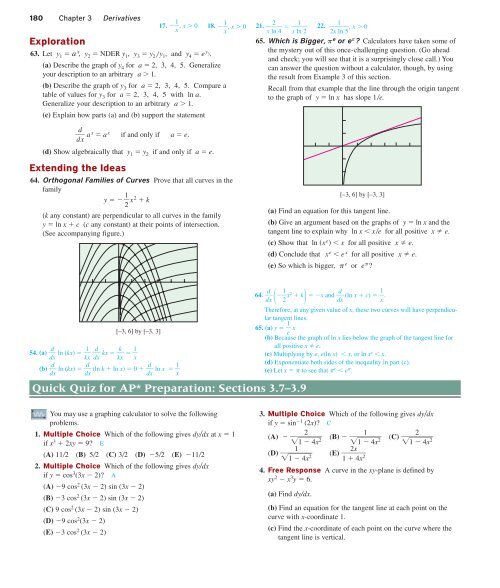5128_Ch03_pp098-184
Create successful ePaper yourself
Turn your PDF publications into a flip-book with our unique Google optimized e-Paper software.
180 Chapter 3 Derivatives<br />
Exploration<br />
17. 1 x , x 0 18. 1 x , x 0 21. x l<br />
2<br />
n4<br />
63. Let y 1 a x , y 2 NDER y 1 , y 3 y 2y 1 , and y 4 e y 3.<br />
(a) Describe the graph of y 4 for a 2, 3, 4, 5. Generalize<br />
your description to an arbitrary a 1.<br />
(b) Describe the graph of y 3 for a 2, 3, 4, 5. Compare a<br />
table of values for y 3 for a 2, 3, 4, 5 with ln a.<br />
Generalize your description to an arbitrary a 1.<br />
(c) Explain how parts (a) and (b) support the statement<br />
1<br />
22.<br />
1<br />
, x 0<br />
x l 2x<br />
n2 ln 5<br />
65. Which is Bigger, p e or e p ? Calculators have taken some of<br />
the mystery out of this once-challenging question. (Go ahead<br />
and check; you will see that it is a surprisingly close call.) You<br />
can answer the question without a calculator, though, by using<br />
the result from Example 3 of this section.<br />
Recall from that example that the line through the origin tangent<br />
to the graph of y ln x has slope 1e.<br />
d<br />
a d x<br />
x a x if and only if a e.<br />
(d) Show algebraically that y 1 y 2 if and only if a e.<br />
Extending the Ideas<br />
64. Orthogonal Families of Curves Prove that all curves in the<br />
family<br />
y 1 2 x2 k<br />
(k any constant) are perpendicular to all curves in the family<br />
y ln x c (c any constant) at their points of intersection.<br />
(See accompanying figure.)<br />
[–3, 6] by [–3, 3]<br />
(a) Find an equation for this tangent line.<br />
(b) Give an argument based on the graphs of y ln x and the<br />
tangent line to explain why ln x xe for all positive x e.<br />
(c) Show that ln x e x for all positive x e.<br />
(d) Conclude that x e e x for all positive x e.<br />
(e) So which is bigger, p e or e p ?<br />
[–3, 6] by [–3, 3]<br />
d 1<br />
54. (a) ln (kx) d x k x d k<br />
kx <br />
dx<br />
k x 1 x <br />
d d<br />
d<br />
(b) ln (kx) (ln k ln x) 0 ln x 1 d x d x<br />
d x x <br />
Quick Quiz for AP* Preparation: Sections 3.7–3.9<br />
d<br />
64. d x 1 2 x2 k x and d<br />
(ln x c) 1 dx<br />
x .<br />
Therefore, at any given value of x, these two curves will have perpendicular<br />
tangent lines.<br />
65. (a) y 1 e x<br />
(b) Because the graph of ln x lies below the graph of the tangent line for<br />
all positive x e.<br />
(c) Multiplying by e, e(ln x) x, or ln x e x.<br />
(d) Exponentiate both sides of the inequality in part (c).<br />
(e) Let x to see that e e .<br />
You may use a graphing calculator to solve the following<br />
problems.<br />
1. Multiple Choice Which of the following gives dydx at x 1<br />
if x 3 2xy 9? E<br />
(A) 112 (B) 52 (C) 32 (D) 52 (E) 112<br />
2. Multiple Choice Which of the following gives dydx<br />
if y cos 3 (3x 2)? A<br />
(A) 9 cos 2 (3x 2) sin (3x 2)<br />
(B) 3 cos 2 (3x 2) sin (3x 2)<br />
(C) 9 cos 2 (3x 2) sin (3x 2)<br />
(D) 9 cos 2 (3x 2)<br />
(E) 3 cos 2 (3x 2)<br />
3. Multiple Choice Which of the following gives dydx<br />
if y sin 1 (2x)? C<br />
2<br />
(A) 1 4x<br />
2 (B) 1<br />
1 4x<br />
2 (C) 2<br />
1 4x<br />
2<br />
1<br />
(D) 1 4x<br />
2 (E) 2x4x 1 2<br />
4. Free Response A curve in the xy-plane is defined by<br />
xy 2 x 3 y 6.<br />
(a) Find dy/dx.<br />
(b) Find an equation for the tangent line at each point on the<br />
curve with x-coordinate 1.<br />
(c) Find the x-coordinate of each point on the curve where the<br />
tangent line is vertical.












